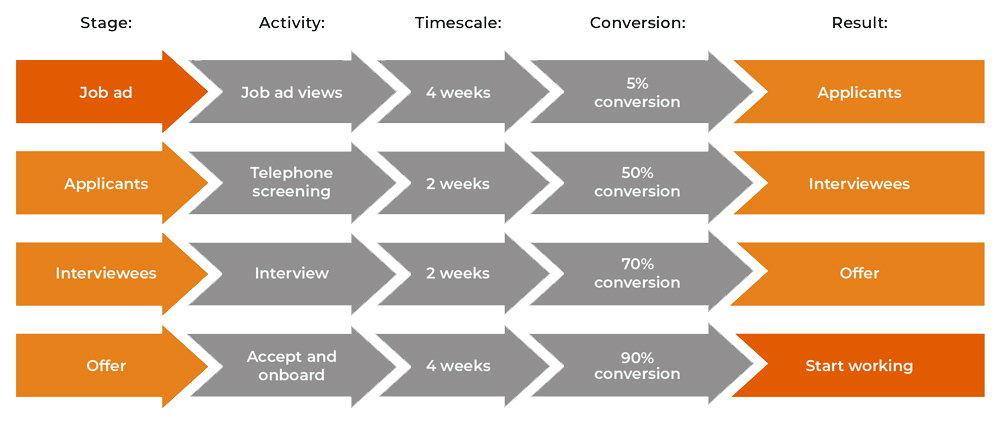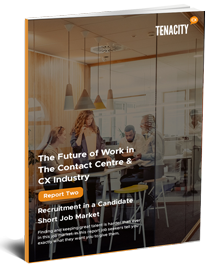In the candidate-short job market we face today, having a great offer for your prospective employees - competitive salary, interesting job role, great company culture, flexible working conditions, learning & development programme, and excellent career prospects - is just the beginning. How you go about making that offer is just as important.
Your recruitment plan should be an ongoing programme of activity – what we call constant recruitment – that builds your profile as an employer and allows you to find and reach out to the types of candidates your business needs to succeed.
Before we look at what your recruitment process might look like, let’s see what it needs to help you achieve:
Extend your talent reach:
Don’t limit yourself to a certain geographical region or type of candidate. Think about where you can uncover new talent pools and new types of candidates who still be a good match for you. This might involve rethinking the core skills your business needs, repackaging jobs up for the skills you can find – for example, splitting up a role between two people – or even creating customised roles that fit the skillsets of talented individuals you want to hire.
In a recent survey by GoodHire, 56% of the respondents said they were changing their hiring practices to include candidates outside of the normal profiles and locations they target. This would allow them to offer remote or hybrid working jobs to candidates who would otherwise not be able to make it into the contact centre – either because they lived too far away or would otherwise be unable to work in an office.
Make it easy on candidates:
In the same survey, 68% said they had changed their hiring practices to make it as easy as possible for candidates by moving to a mostly remote process.
Everyone we spoke to moved to a 100% remote recruitment process during the pandemic. Most of them are retaining this model as it is more efficient, easier for the candidates, and seems to get better results and better people. Candidates want a faster response and remote recruitment facilitates this. As we say from our survey results, they also respond well to employers who get back to them quickly – even if it’s a no, they want to know where they stand.
There are a number of Zoom interviews. We do psychometric testing to get another layer of understanding and determine whether they’re a good fit. We’ve always done that face-to-face but now we’ve moved to Zoom. The key is to constantly re-evaluate. If somebody doesn’t work out assess what you missed in the process that might have told you they weren’t right for the role.
Head of Contact Centres, Australian Global Financial Services Company
Enable you to hire quickly:
You must have a clear recruitment plan with clear milestones from the day you identify a need to the day a new hire starts work. We had one client, for example, who said it usually took them 5 months to go from deciding to hire for a new role to that person starting work. That kind of thing is always down to internal processes and policies, so sweep them away. Make your processes as streamlined and seamless as possible, and as painless as possible for candidates. Remember they are being offered and counter-offered in this job market, particularly if they’re any good. Have a plan, move quickly, and eliminate bureaucratic obstacles.
The way we recruit and onboard has forever changed. Candidates used to come into the office to be interviewed, then come in again, and then wait. That’s all been replaced by a video call now. Candidates want a faster response as they have more options. Employers that have a slick and effective approach to recruitment will get the best candidates.
Head of Wealth Contact Centres, Big 4 Bank
According to SEEK the average time to fill vacancies has gone up from 14 days to an incredible 3 months. This is explained by the fact that, since the start of the pandemic (comparing July 2022 to July 2019), there has been a 52% increase in job ads placed on SEEK at the same time as a 48% decrease in applicants per job. So don’t be average – make sure you have a slick process so you can reduce the time to fill.
The constant recruitment philosophy
In the current job market almost all organisations, and certainly most contact centres, need to have an ongoing recruitment programme. If you are a contact centre or CX function with a headcount of 50, you are likely to have to replace one to two agents a month at an average annual attrition of 30% to 40%. And it could be higher now. A 500 FTE operation will on average need to recruit 10 to 20 people a month just to keep up with attrition, not to mention growth.
By the time an agent leaves, or hands in their notice, it is too late. Even if you start looking for their replacement immediately, you’re going to have a gap. Instead, you should be constantly recruiting to keep pace with your expected replacement rate. Your recruitment pipeline should always be full so that you have qualified candidates ready to step up as soon as you need them. In our experience, constant recruitment works much better than stop-start campaigns where you blitz hire 20 candidates in one go.
If you know how many candidates you need to screen to find a single good one, and you know how many interviews you need to conduct for each offer you make, you can work how long it’s going to take you to fill your vacancies. It’s just a case then of working the numbers, like the example below.
Example recruitment pipeline
Here we’ve broken the standard recruitment process into four stages. You should know how long each stage generally takes, and what your conversion rates look like.

What does this mean?
Although recruitment is certainly more difficult today than under pre-pandemic market conditions, it is far from impossible. It just requires a more methodological approach and an ongoing programme of activity. We call it constant recruitment.
Focus on the 3 things discussed in this section and you should, at the very least, be able to replace staff lost to attrition while maintaining the quality of people you hire. Your priorities should be to:
Build your recruitment brand and position yourself as an employer of choice with your target talent pools.
Create a market-leading or market-beating offer that includes above-average remuneration and plenty of other benefits such as flexible working.
Put in place a structured candidate attraction plan and a recruitment pipeline that casts your net for talent as wide as possible.
Free Report
Download our latest free report "The Future of Work in the Contact Centre & CX Industry: Recruitment in a Candidate Short Job Market" for a deeper dive into these topics.
Download Now


